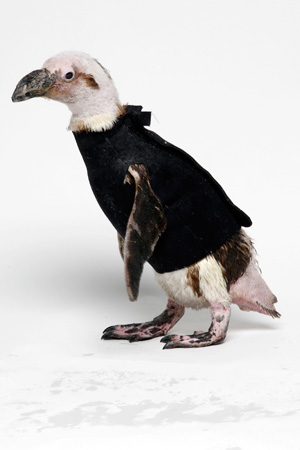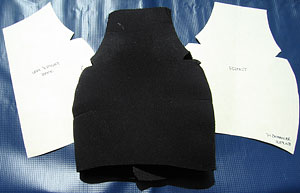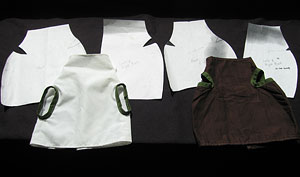A "penguin suit" doesn't just refer to a tuxedo anymore.
 Why does Pierre, the Academy's 25-year-old penguin
Why does Pierre, the Academy's 25-year-old penguin
need a wetsuit?Thanks to an innovative treatment at the California Academy of Sciences. Pierre, the Academy's 25-year-old penguin was recently fitted with a wetsuit! Pierre's feathers were thinning and not growing back. Because penguins rely on their feathers for warmth, Pierre was often shivering and uncomfortable without the protection of his feathers. When medical tests concluded there was no medical reason for the feather loss and more conventional treatments proved unsuccessful, senior aquatic biologist & penguin handler, Pam Schaller came up with a more creative approach to keep Pierre warm.
Pam was very familiar with the warmth of wetsuits. She then mused why couldn't a wetsuit be designed for a penguin? She approached Academy veterinarian, Freeland Dunker with her left field idea. At first, he was dubious but after talking with Pam, he agreed it was worth a try as long as the wetsuit was fitted to insure it did more good than harm. In other words, as long as the wetsuit was fitted not to impede movement or cause rashes, it was worth a shot. Pam knew the best person to design a custom wetsuit would be Celeste Argel, the Early Childhood Specialist at the Academy, who is an excellent and creative seamstress. Celeste was asked to collaborate with Pam to develop and fit a wetsuit just Pierre's size.
But how do you go about designing a penguin wetsuit? The answer seems to be trial and error. Celeste sat down with me and went over the details about the unusual experience. The process from idea to creation required a great deal of patience and re-fitting.
 Celeste, Pam and Pierre met several times in order to customize dimensions. The first fitting consisted of Pam restraining Pierre in order for Celeste to take measurements. From the start, Celeste marveled at the strength of Pierre. "From far away," she commented, "penguins just look so cute and cuddly but being up close gave me an appreciation for just how strong penguins really are." With measurements in hand, Celeste drafted up a pattern for the wetsuit and created the first prototype from white cotton bed linens.
Celeste, Pam and Pierre met several times in order to customize dimensions. The first fitting consisted of Pam restraining Pierre in order for Celeste to take measurements. From the start, Celeste marveled at the strength of Pierre. "From far away," she commented, "penguins just look so cute and cuddly but being up close gave me an appreciation for just how strong penguins really are." With measurements in hand, Celeste drafted up a pattern for the wetsuit and created the first prototype from white cotton bed linens.

